Archived Storm Damage Blog Posts
Storm Damage? Call SERVPRO®
9/19/2023 (Permalink)
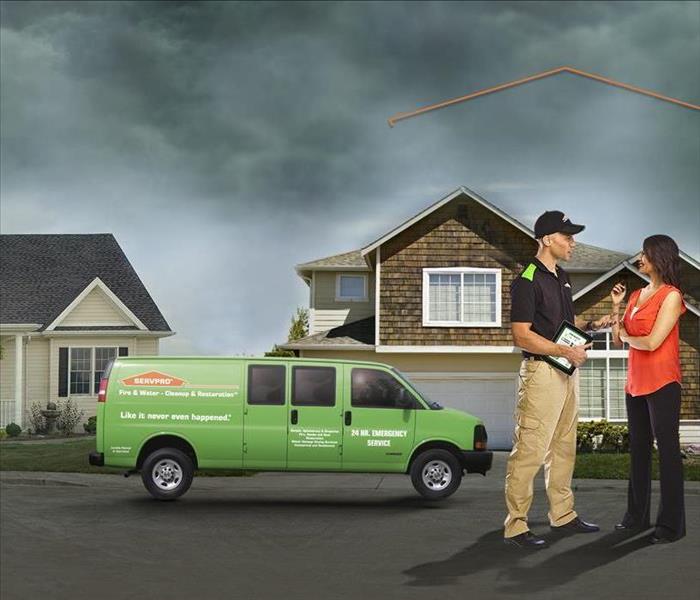 SERVPRO has 24-hour Emergency Services to respond quickly to disaster.
SERVPRO has 24-hour Emergency Services to respond quickly to disaster.
Storms can be unpredictable and take a toll on your home or commercial space, which can cause damage to both the interior and exterior of your property. SERVPRO of East Independence/Blue Springs understands that these disasters can come at any time and provides emergency services 24 hours a day, 7 days a week. We have trained, on-call professionals to respond to your loss, and our teams make it a priority to be faster to any size disaster. This immediate response time can lessen damage, cleaning time and costs as further damage will be prevented. So, if your property is ever impacted by storm damage, do not hesitate to call SERVPRO of East Independence/Blue Springs at any time, day or night. We are always Here to help.
For residential services that can bring you peace of mind when something goes wrong, SERVPRO offers water damage restoration, fire damage restoration, mold remediation, storm damage restoration, general cleaning and building services. A commercial property impacted by damage can also be restored by SERVPRO with services such as commercial water damage restoration, commercial fire damage restoration, commercial mold remediation, storm damage and large loss event restoration, and cleaning services.
Be Prepared for Storms with Water Purification
9/28/2022 (Permalink)
 If you experience storm damage to your residential or commercial space, contact SERVPRO.
If you experience storm damage to your residential or commercial space, contact SERVPRO.
When powerful storms leave behind chaos, you should always check your property for damage once it is safe. SERVPRO of East Independence/Blue Springs can be here to help. Even if your property isn’t directly affected, you might have to deal with some consequences of such extreme weather.
An important thing to plan for is having drinkable water. A storm does not wait for those in its path to be prepared, so don't hesitate to create a plan and storm preparation kit to keep in your home. A storm kit should include water bottles, blankets, nonperishable food, a flashlight and first aid kit, portable chargers, and necessary personal care items. A list of other storm preparation items can be found here.
If you come into a situation where you do not have drinkable water, here are ways to purify and store contaminated water.
Finding the Perfect Container is the first thing you will want to do is find containers that have a narrow neck which would make it easier to pour. You should never use a container that has been used for cleaning supplies or other toxic chemicals.
Ways to Purify Water
- Boiling the water is one of the safest ways to kill germs, including viruses, bacteria, and parasites. You will want to continue boiling for one minute for elevations 6,500ft or less and for three minutes for higher elevations. After that, you will want to let the water sit and cool before transferring it to a storage container.
- Using Water Purification Tablets
The other option we will discuss is using water purification tablets to help purify the water when you cannot bring it to a boil. The active ingredient is usually chlorine, chlorine dioxide, or Iodine, which deactivate harmful pathogens by rendering them harmless. We suggest purchasing a bundle and storing them in your storm preparation kit with a 3-year shelter life; these will be handy during storms and hiking trips; click here.
It's National Preparedness Month!
9/16/2022 (Permalink)
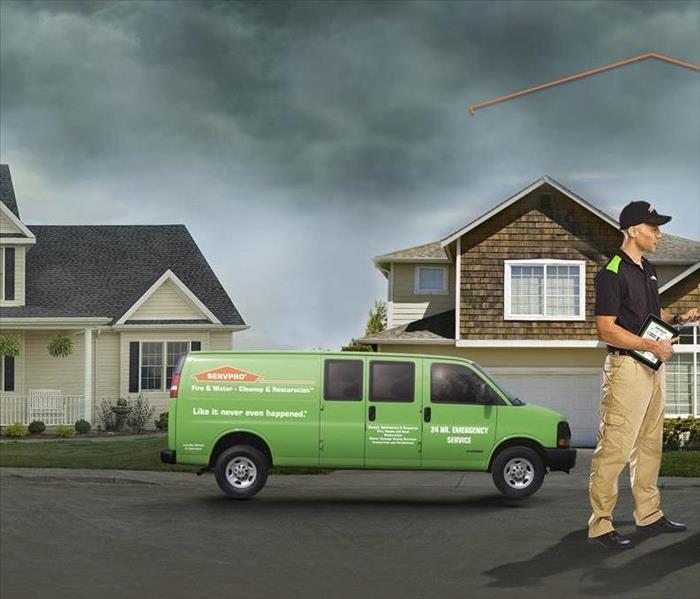 SERVPRO is Here to help after a natural disaster takes a toll on your property.
SERVPRO is Here to help after a natural disaster takes a toll on your property.
Ready.gov describes National Preparedness Month as "an observance each September to raise awareness about the importance of preparing for disasters and emergencies that could happen at any time."
Now, SERVPRO of East Independence/Blue Springs knows a thing or two about disasters as a premier cleaning and restoration company. We restore storm damage to your property such as roofing and water damage.
To be better prepared for possible natural disasters, follow these tips.
- In the event of hurricane weather, take refuge in the highest level of a building but not a closed attic.
- If a wildfire is near, remove weeds, brush and debris from property, and trim back grass and branches.
- To be prepared in the event of a tornado, create a safety plan for your home that identifies safe areas, utility switch offs, and what to do in an emergency.
Staying Safe in the Tornado Shelter!
12/13/2021 (Permalink)
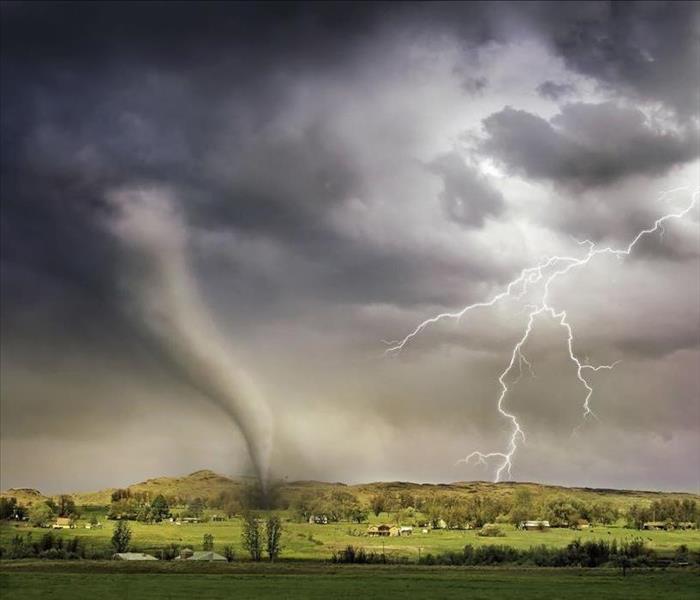 When a tornado hits, you will want to be safe in your shelter to ensure the safety of you and your family.
When a tornado hits, you will want to be safe in your shelter to ensure the safety of you and your family.
Witnessing a tornado is very nerve-wracking for anyone to live through; in fact, many homeowners aren’t prepared for a tornado to strike. You will want to continue reading to ensure your home is ready for mother nature to hit.
Being Prepared for Whatever Happens.
This is a step that one should take before a tornado strikes, as this will help keep you alive if a tornado hits. It would be best to have fresh batteries and a battery-operated radio to listen to the emergency weather service alert. Draft up a tornado plan that includes where you and your family will take shelter as the storm passes. You should keep a kit that provides water, canned foods, and medications to ensure that your family is safe if you get stuck.
Pay Close Attention to Development Outside
Often, people will go outside during a storm to storm watch. This is okay if you are safe, but you should seek shelter as soon as you notice the sky turning into a dark or green color or a low dark hanging cloud. If you hear a loud sound like a freight train, you should immediately seek shelter.
Know Where Shelter is Located
Tornadoes are notorious for flinging debris, the leading cause of deaths or injuries during a tornado. Knowing where your tornado shelter will be critical when it comes to keeping your family safe. You will want to have yourself in an area free of windows due to the glass shattering, which can cause damage to yourself. Finding a place like under a workbench or a table will help keep your head protected if the house were to collapse. The most critical safety tip would never be staying in a mobile home during tornado conditions.
Protecting Your Devices with a Surge Protector
12/13/2021 (Permalink)
 Protect what matters the most to you. Unplug all devices during a thunderstorm to ensure they are protected from a power surge.
Protect what matters the most to you. Unplug all devices during a thunderstorm to ensure they are protected from a power surge.
Multiple sources can create an energy surge, but what is left is wreak havoc for your electronics, appliances, and electronic outlets. Lighting can cause a power surge by striking a home’s electrical system, which accepts this extra energy hence frying the system. Sometimes people will over plug each plugin with appliances above the greater amperage than what is intended for that circuit.
Here are some easy ways to prevent your circuits from experiencing a power surge during a storm.
- Unplug Everything During a Storm
This might be the most helpful trick to protect yourself when preventing a power surge. You should unplug any home appliances, computers, or gaming systems.
- Distribute your Appliances
Instead of having a few plugins full, you should distribute the appliances between a few outlets. This ensures you are not overwhelming certain outlets that will accept the energy source that fries your devices in return.
- Purchase A Surge Protector
A power surge follows a power outage, and it is caused when a large jolt of electricity powers back. A Surge protector absorbs the jolt and doesn’t allow the devices to this jolt which protects it from being fried.
Follow these three steps to keep your contents safe from a possible power surge.
Making a Claim Due to Tornado
12/6/2021 (Permalink)
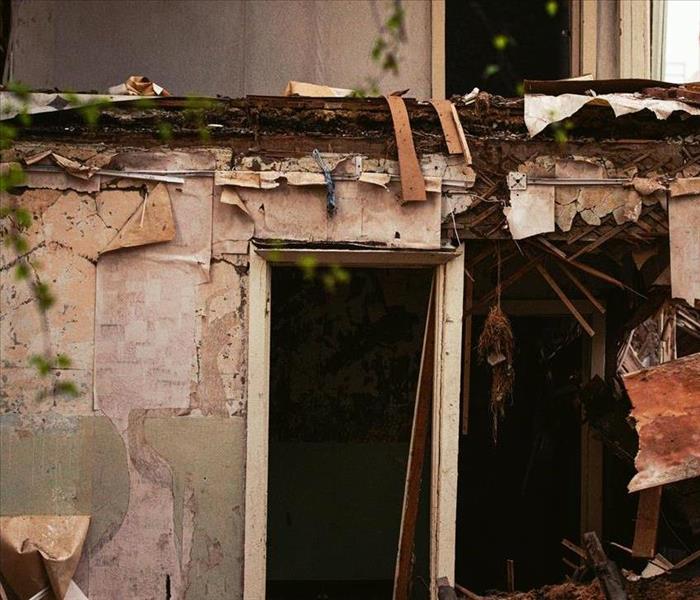 A tornado can create unimaginable damage to someone's home.
A tornado can create unimaginable damage to someone's home.
Dealing with the destruction of your property caused by a tornado can be a very stressful event. Especially when it might feel like a mountain of tasks for you to complete, this article will go over the steps you should take after a tornado causes damage to your property.
- Contact your Insurance Company
- When talking with your insurance agent/provider, you will want to write down the name and contact number.
- You will want to write down the topic discussed, projected timelines previously given, and the list of documentation previously discussed.
- Keep track of these conversations, and feel free to reference previous conversations when speaking to someone new. This documentation will help them know exactly what you will need so you can get right to the point.
- Contact your Local SERVPRO
We will take over documenting your damage to ensure that the insurance adjuster is given proper documentation from this moment on.
- Our team of professionals will compile pictures, communication logs, and anything the adjuster may need.
- The project manager will create a strategic plan using our proprietary data software to lay the expectations for our crew.
- We have the means to help our customers, including reconstruction services.
- Providing Documentation to Adjuster
- Our team aims for such a standard of documenting that the adjuster will find it sufficient to finish the claim for the client.
Winter Weather Brings Destruction for Your Home
11/16/2021 (Permalink)
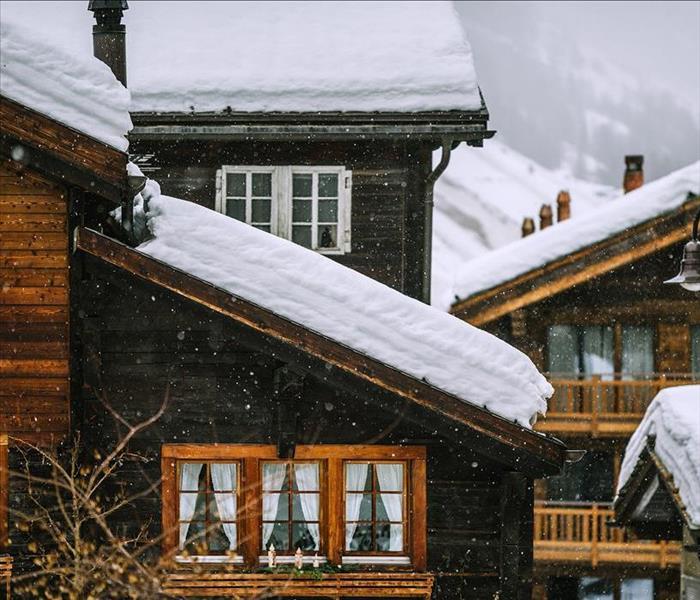 By providing maintenance on your home, you will ensure it's ready for the winter.
By providing maintenance on your home, you will ensure it's ready for the winter.
It doesn’t matter if you are a winter holiday fan because here we go as we approach another winter season. Did you know that the winter season can bring extensive destruction to your home if you are not careful? Jack Frost can’t stand a chance when you have your friendly SERVPRO professionals here to help.
Wind + Frozen Branches = Massive Headaches
Everyone will admit that they enjoy a pleasant stroll through the park during the first snow of the season. The die-hard winter lovers will realize that they enjoy seeing ice-covered trees because it’s peaceful. What isn’t friendly is the possibility that when the wind picks up, it could break the branch off the tree and land on your home. If a bigger branch falls onto your home and causes damage that needs reconstruction services, yes, you got it. SERVPRO can help rebuild anything that mother nature breaks.
Frosty is Melting + Crack in Foundation = Flooded Basement
The kiddos might wish for more snow so they can enjoy another snow day. The dogs might be excited to shove their face right into the snow. Parents are stressed because of the slushy mess that the kids and/or dogs are tracking in. Slush is the least of your worries because that ice and that snow might be creating tiny cracks in the foundation of your home. This is a problem because when the snow melts, there is a chance that water will seep through the cracks causing water damage. When you have moisture soaking onto your carpet or wall mixed with the warm temperatures inside the home might create perfect scenarios for mold to thrive in.
These are two examples of ways that winter weather can create more significant problems for your home. Staying on top of the maintenance of your home will ensure that a bigger disaster isn’t waiting to make an appearance.
How Do Thunderstorms Form?
9/28/2021 (Permalink)
Thunderstorms can form anywhere in the world, at any time, as long as the conditions are right.
A thunderstorm starts when warm moist air near the surface of the earth heats up and begins to rise upward. Because the warm, moist air is less dense, it creates lift, or what is called an updraft. That warm moist air continues to rise and expand. Because air pressure drops as it travels higher, the temperature of the air falls. Water vapors condense at higher altitudes, creating clouds. When water vapors condense, they release heat, and the initial warm moist air will regain some of the heat it lost while expanding and cooling. Thus, the first step of a thunderstorm is a vicious cycle of warm, moist air rising, cooling, and condensing.
The second part of the equation is a little more complicated.
The clouds will darken as they fill with water vapor and release the water. This release of water creates a downdraft. While that warm moist air is rising into cool dry air and creating clouds, the water vapors will turn to ice. Because the ice is too heavy to be supported by the updrafts, it falls back to the bottom of the cloud. While the ice is falling, it can bump into the other particles and break apart – this rubbing of smaller particle pieces falling creates static electrical charges within the clouds. Eventually, a separation of excess positive charges (top of the cloud) and the negative charges (bottom of the cloud) will form. When the charge is too strong to be contained within the cloud, it lets out the energy. The negative charge from the bottom of the cloud crawls down to meet a positive charge and a lightning stroke appears (what we call a lightning strike). The lightning stroke creates a channel mid-air. When the light disappears, the air collapses back in, and the rapid expansion of air creates a sound wave that we know as thunder.
Storm and flood damage require specialized restoration techniques and equipment. When a storm hits your home, you need a company with storm damage experience and expertise. So you can call on our team to help you!
Source: ISCN
Getting a Board-up in Blue Springs
9/17/2021 (Permalink)
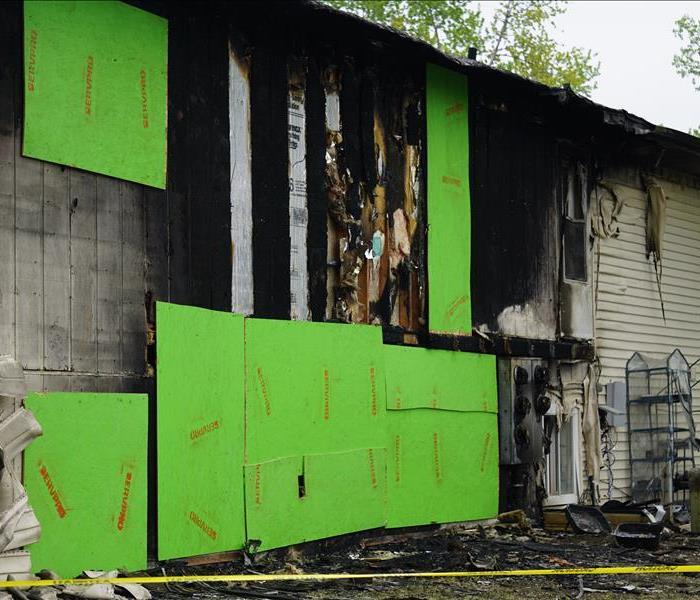 We have the equipment and capabilities to board-up a community after a natural disaster. We are able to help no matter the size of the job.
We have the equipment and capabilities to board-up a community after a natural disaster. We are able to help no matter the size of the job.
With indudtry-approved training to employ rapid response, the utmost professionalism, cutting-edge technology, and open communication. We not only strive to restore the business but also your peace of mind.
A board-up is done after a fire or storm to help prevent further damage to the facility. It minimizes property loss by securing the building and taking care f restorable and reusable elements. A natural disaster can leave your facility vulnerable to problems such as vandalism, theft, and unwanted entry. SERVPRO franchise professionals care about proper restoration and board-ups of your property, and in most damage situations, our team can safely restore to preloss conditions in a timely manner no matter the size of the property. Our team is here to help.
Tornado Safety
3/2/2018 (Permalink)
As we remember the EF3 tornado that brought destructive winds, ranging from 136-165 mph, tearing through our community of Oak Grove, MO just one year ago on March 7th 2017, we want to remember more than the furious funnel, it’s path 7 miles wide, that caused damage to 483 homes, 12 businesses and caused 15 injuries. We want to remember to the quick response and care from our townsfolk and make certain we all know what to do, if this type of force strikes again. While we are grateful for the low number of 15 injuries, preparedness could get that number down to 0
If you are at home during a tornado:
- Go to a storm cellar or basement if your house has one. If there is no basement, go to an inner hallway or a smaller inner room without windows, such as a bathroom or closet.
- Get away from the windows.
- Go to the center of the room. Stay away from corners because they tend to attract debris.
- Get under a piece of sturdy furniture such as a workbench or heavy table or desk and hold on to it.
- Use your arms to protect head and neck.
- If you are in a mobile home, get out and find shelter elsewhere.
If you are at work or school during a tornado:
- Go to the basement or to an inside hallway at the lowest level.
- Avoid places with wide-span roofs such as auditoriums, cafeterias, large hallways, or shopping malls.
- Get under a piece of sturdy furniture such as a workbench or heavy table or desk and hold on to it.
- Use your arms to protect head and neck.
If you are outdoors during a tornado:
- If possible, get inside a building.
- If shelter is not available or there is no time to get indoors, lie in a ditch or low-lying area or crouch near a strong building. Look out for flood waters which may also fill low areas.
- Use your arms to protect head and neck.
If you are in a car during a tornado:
- Never try to drive faster than a tornado in a car or truck. Tornadoes can change direction quickly and can lift up a car or truck and toss it through the air.
- Get out of the car immediately and take shelter in a nearby building.
- If there is no time to get indoors, get out of the car and lie in a ditch or low-lying area away from the vehicle. Be aware of the potential for flooding.



 24/7 Emergency Service
24/7 Emergency Service






